1941 Wheat Penny Coin Value: How Much Is It Worth?
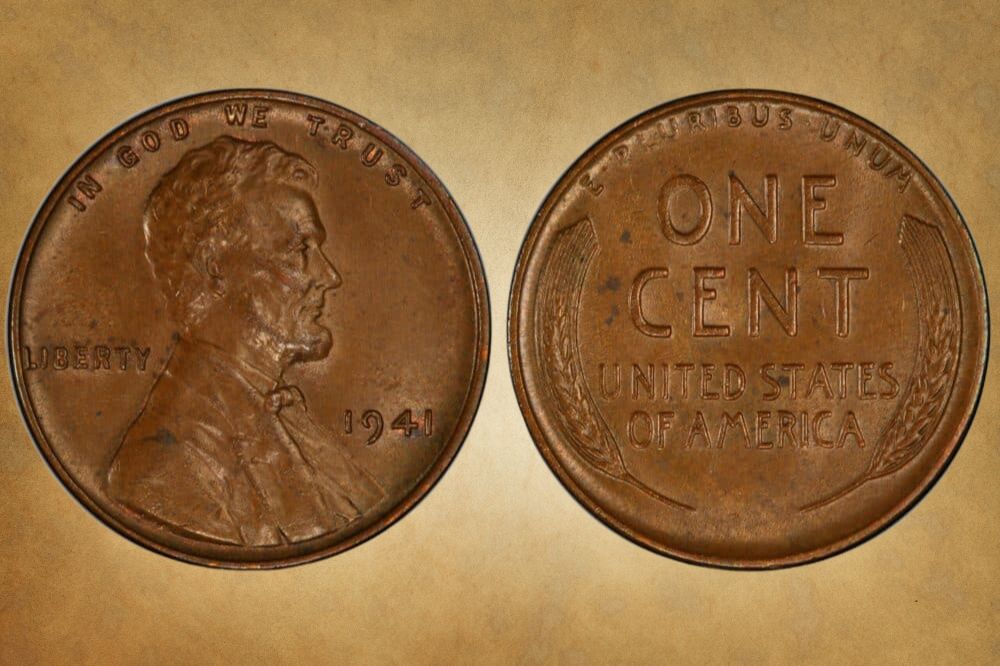
The penny minted in 1941 was one of a long series. It’s sometimes known as the Lincoln penny, or Lincoln cent. And Lincoln pennies are still being minted to this day.
So is the 1941 penny value anything special? And if so, what makes it interesting to collectors?
We’re here to answer that question. So if you’re ready, let’s dive in.
1941 Penny Value Chart |
|||||
| Type | Circulated | MS64 | MS66 | MS67 | MS68 |
| 1941 No Mint Mark Penny Value | 15 to 20 cents | $12 | $60 | $400 | $10,500 |
| 1941 D Penny Value | 15 to 30 cents | $15 | $70 | $850 | $15,000 |
| 1941 S Penny Value | 15 to 30 cents | $17 | $65 | $875 | None |
| 1941 Proof Penny – Brown Value |
|
||||
| 1941 Proof Penny – Red-Brown Value |
|
||||
| 1941 Proof Penny – Red Value |
|
||||
1941 Penny Value Guides
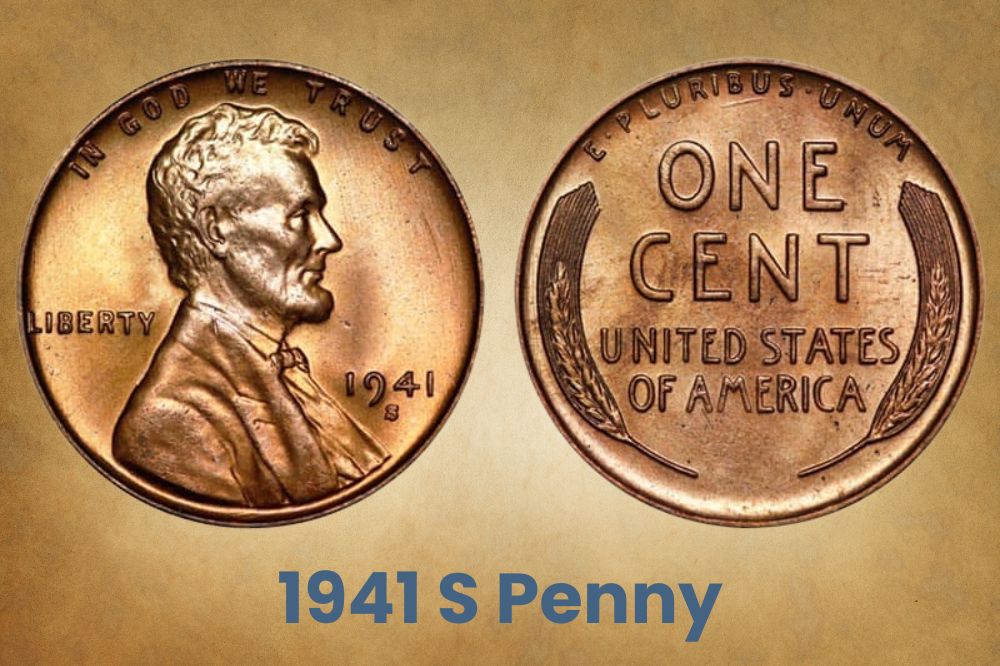
1941 Penny, Circulated Value
Over 1 billion 1941 pennies were minted. The Mint’s facility at Philadelphia contributed the lion’s share, with just over 887 million coins minted there. In Denver, the figure was almost 129 million, and in San Francisco it was just over 92 million.
The high numbers produced mean that it’s not difficult to find circulated examples of any of these coins today. For the Denver and San Francisco coins, a “D” or “S” respectively will be found on the obverse beneath the date. With coins minted in Philadelphia, there’s no mint mark.
Circulated Philadelphia 1941 pennies can be picked up for between 10 and 20 cents apiece. You might have to pay an extra 10 cents for a coin minted in Denver or San Francisco.
1941 Penny, Mint State Value
When it comes to the value of mint state coins – those never destined for circulation – grading is key.
Mint coins are graded from 60 to 70 depending on their condition and the quality of the strike. For coins of the same grade, there’s generally a modest premium for a Denver coin over one from Philadelphia. And San Francisco coins tend to command higher prices than those from Denver.
The key factor in price, though, is the relative scarcity of the coin at that grading. And coins that are the finest examples of their type achieve the highest prices.
For 1941 pennies minted in Philadelphia or San Francisco, the highest grade known to exist is MS68. A Philadelphia coin at that grade will fetch around $10,500, while one from Denver will fetch around $15,000.
Just one grade lower, at MS67, and prices drop steeply. At this level, numerous coins are known to exist. A Philadelphia MS67 penny sells for around $400. The price for the same grade from Denver is about $850, and it’s about $875 for a San Francisco example.
1941 Penny, Proof Value
Proof pennies weren’t struck every year. But in 1941, 21,100 proof coins were struck in Philadelphia. The coins were aimed at collectors and were struck using specially made dies on carefully selected planchets.
But while their quality is excellent, the fact that they were collectors’ pieces from the outset limits their value. That’s because most examples will have been carefully stored away. And that means they’re still available in relatively high numbers today.
As with mint state coins, their value depends on their grade. And red coins command higher prices than red-brown examples, which in turn are generally more desirable than brown coins.
A 1941 red proof penny graded PR67 is worth around $5,400. At the other end of the scale, a brown proof graded PR63 can be bought for around $40.
Related Posts: 16 Most Valuable Wheat Penny Errors
1941 Penny Errors
1941 Penny, Double Die Obverse
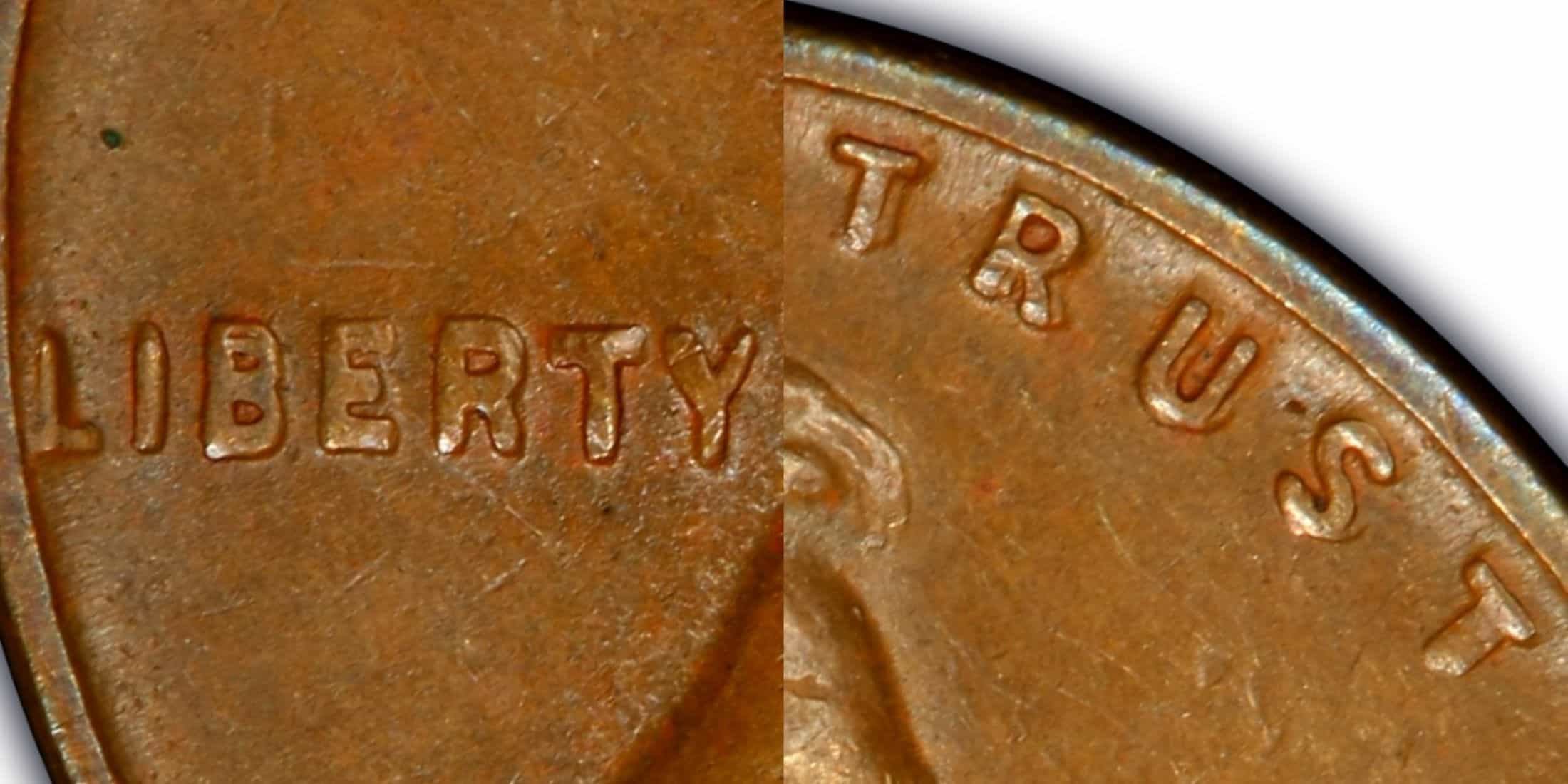
A double die error is one of the more common types of coin errors, and it occurs when a die is made.
Repeated strikes are needed to transfer all the detail from the original design to the die. And if one of those strikes is misaligned, it produces a ghostly double image on the die. That’s then transferred to the coins.
Sometimes doubling appears on both sides of the coin, but it’s more usual to find it on one side or the other. Depending on where it’s visible, it’s known as a “double die obverse” or “double die reverse” error.
A good place to look for doubling in 1941 pennies is the motto “In God We Trust”. Look at the edges of the lines and you may see a faint double line.
A coin that has this error will be worth around $120, even in XF45 (extremely fine circulated) condition. At MS63 that rises to $300, and at MS65 Red it’s $1,200.
A second known error shows less pronounced doubling in “In God We Trust”. And in a third variety, the doubling appears in the letters of “Liberty” and the date.
This YouTube video from Rob Finds Treasure shows how to spot the three different varieties of double die obverse error.
1941 Penny, Experimental Planchet
As the Second World War led to an increased demand for copper and tin for munitions, new options were sought to reduce the metal used in coinage. From 1909, Lincoln pennies had been made of 95% copper and 5% tin. But both those metals were in high demand for the war effort.
The Mint experimented with a variety of different materials. While the resulting coins are experiments rather than errors, they are still very rare.
One such coin was presented for auction in 2005. The copper content had been reduced to 90 per cent, with 5 per cent zinc added to the standard 5 per cent tin. It was graded MS64 red-brown. And it fetched a price of over $600.
Related Posts: 19 Most Valuable Lincoln Memorial Penny Worth Money
History of the 1941 Penny
The 1941 penny came 32 years into the series of Lincoln pennies. The first cents bearing the former president’s image had been minted in 1909 to mark 100 years since his birth.
The first coins to be issued had attracted huge public interest. People queued around the block at all the mint facilities, keen to acquire them. There had been no prior information on the design, so curiosity was at fever pitch.
Many of those lucky enough to get their hands on the first coins sold them on the secondary market. Prices peaked at 25 cents per coin before settling down to the more reasonable price of five cents.
There were some initial teething problems with the new design. Vending machine companies complained the coins were too thick to fit slots. And there was a row over the appearance of the coin designer’s name on the reverse, which some considered “advertising”.
Things settled down, and in 1936 the first ever proof Lincoln pennies were struck in Philadelphia.
But three years later, the Second World War brought new challenges. Metal was in short supply for transport and munitions. The copper and tin used in the Lincoln pennies was needed elsewhere. Legislation was passed authorizing the coins to be made from steel and zinc instead.
The 1941 penny was the last to be produced in copper before the new legislation took effect. The pennies minted in 1942 look quite different, appearing silver in color instead of red or brown.
In 1943, though, copper was used once again. At first the coins were made from a copper-zinc alloy. Later the zinc was removed, and there was a return to the copper-tin alloy used in the original pennies.
The design continued largely unchanged from 1909 to 1958. But 1959 marked the 150th anniversary of Lincoln’s birth. The reverse design changed from ears of wheat to an image of the Lincoln Memorial.
Related Posts: 19 Most Valuable Wheat Penny Worth Money
how to identify 1941 Penny
The Obverse of the 1941 Penny
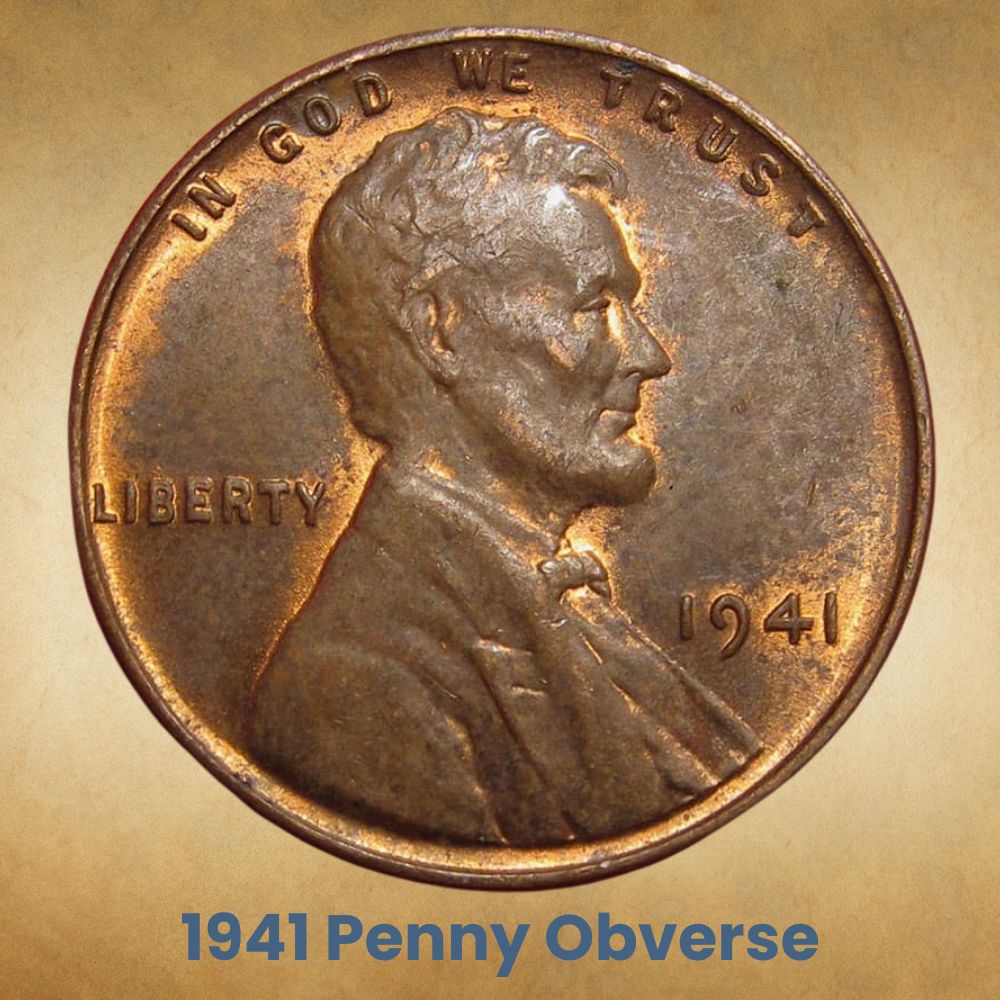
The obverse – or “heads” side – of the 1941 penny bears the image of Abraham Lincoln. Above it, the words “In God we trust” curve around the top edge. The word “Liberty” appears to the left of the portrait as the coin is viewed, while the date is on the right.
Lincoln’s portrait was the work of a sculptor called Victor David Brenner. President Roosevelt had sat for Brenner in 1909, and it may have been this that earned him the job.
Brenner had already produced a number of different images of Lincoln. The one on the penny appears to have been based on a plaque crafted in 1907 for a manufacturing company. Brenner said that he had depicted the president as he imagined he would have looked if reading to a child.
1916 saw some minor changes to the design. The Mint’s chief engraver, Charles Barber, made Lincoln’s cheek and coat less wrinkled. He said that the changes were to prolong the life of the dies used to strike the coins.
1918 saw another minor change. Brenner’s initials, which had briefly appeared on the reverse of 1909 coins before being removed, were reinstated. This time they appeared on the obverse, tucked discreetly into the lower edge of Lincoln’s bust. All 1941 pennies carry Brenner’s initials.
The Reverse of the 1941 Penny
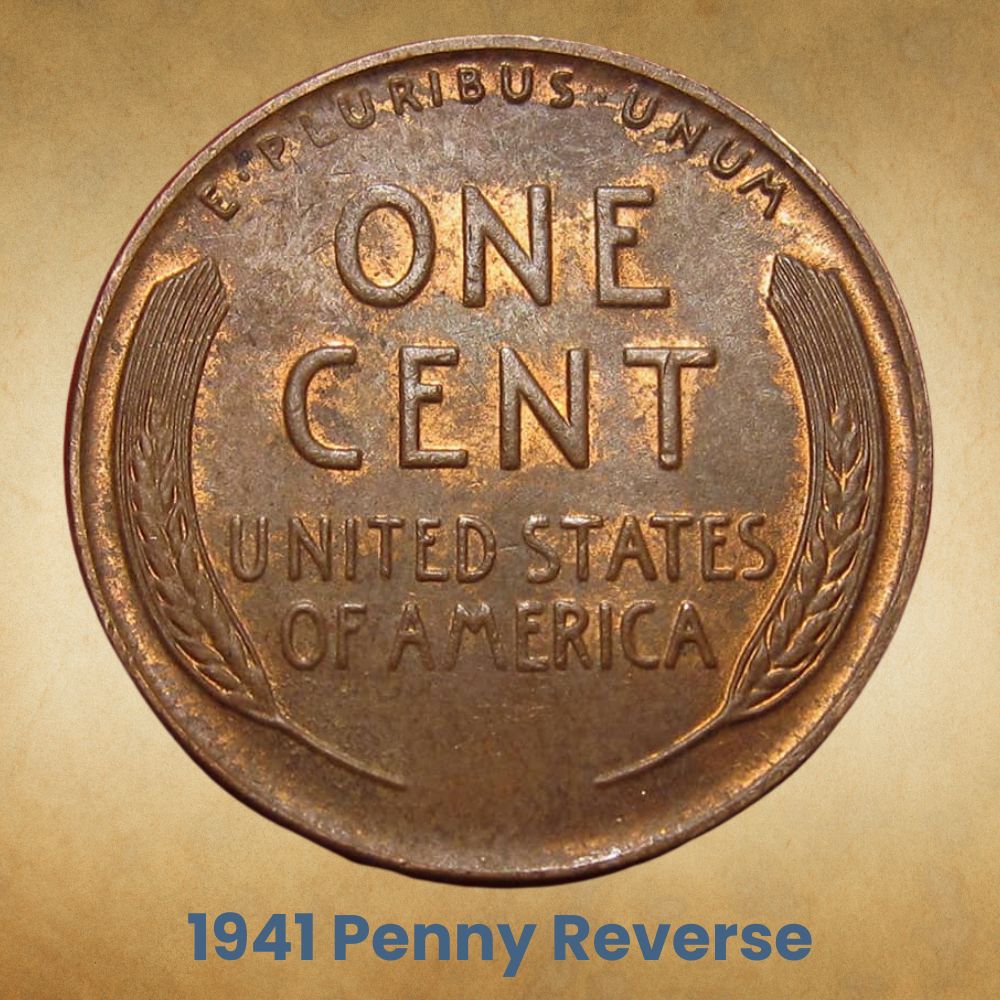
Like the obverse, the reverse of the Lincoln penny was designed by Victor Brenner. But it was his second design that made the cut.
He had first suggested an image of the branch of a tree. But this was almost the same as a design being used on French coins at the time.
The Mint Director, Frank Leach, didn’t confront Brenner with evidence of his copying. But he did tell him the image was unsuitable, and asked him for a new and simple design. This, he said, should incorporate the country’s name, the coin’s denomination, and the Latin motto “E pluribus unum”.
Brenner submitted a new design just a week later. This one would grace the reverse of Lincoln coins for almost 50 years. It showed two ears of durum wheat curving around the sides of the coin.
The design was signed with Brenner’s full name – but that was highly controversial. Some saw it as an attempt at self-advertisement. Brenner agreed that his name should be replaced by his initials, an approach which had been used by a number of designers in the past.
But that was not enough to satisfy everyone. The new initials, it was felt, were too large.
Coin production was halted while discussions took place on what to do. Replacing the initials with a smaller version would have taken two weeks. Removing them altogether could be done in just three days. Despite Brenner’s protests, his initials were deleted.
In 1918, they were reinstated, this time on the obverse.
Other Features of the 1941 Penny
Like other copper coins, the color of 1941 pennies varies significantly. When brand new, copper has a red tone. But as time went by, handling and exposure to oxygen in the air darkened the coins.
The professional coin grading agencies classify copper coins into three color categories: red, red-brown and brown. Generally speaking, red coins are considered more desirable than brown.
For a coin to be classified as red, it must retain the original red tone on at least 95 per cent of its surface area. That’s very unusual in a circulated coin.
A coin classified as brown will have the red color remaining on less than 5 per cent of its surface. And coins classified as red-brown fall anywhere between those two extremes.
This YouTube video from Couch Collectibles shows you how to distinguish between red and brown Lincoln pennies.
FAQs
What makes a 1941 penny rare?
Most 1941 pennies aren’t rare or valuable. But mint state coins graded at the higher levels are much rarer. Examples graded MS67 or MS68 are very rare. And the same goes for proof coins graded at PR65 or above.
Error coins are much rarer than regular strikes. Look for any of the three varieties of double die obverse errors known to exist on 1941 pennies. And experimental coins made of something that’s not 95 per cent copper and 5 per cent tin are rare too.
How much is a 1941 penny worth?
Circulated coins from any of the mints are generally worth a maximum of 20 to 30 cents. But a coin graded MS67 will be worth several hundred dollars. Coins classified as red will carry a premium too.
Proof coins, particularly in higher grades, fetch much more than their face value. A PR63 1941 penny can be bought for around $40. But at PR67, a red coin is worth more than $5,000.
Error coins and those made on experimental planchets are valuable too. Prices can range from around $100 to several thousand.

I truly hope it was just an innocent mistake but you provided the wrong dates for steel pennies. Your article states that in 1942 the pennies look “silver in color” and went back to copper in 1943. When actually the 1943 pennies were made of steel, with very very rare copper varieties known to exist. 1944 saw the return to copper though a few rare steel pennies from that year are known to exist. This quite well known thus makes it difficult to rely on any of the other knowledge you shared in regards to the 41 penny and its value.
I have a 1941 wheat penny and it’s copper in color and fklakes off in a lot of parts that look steel or shiny silver is it a experimental coin or is it worth anything at all